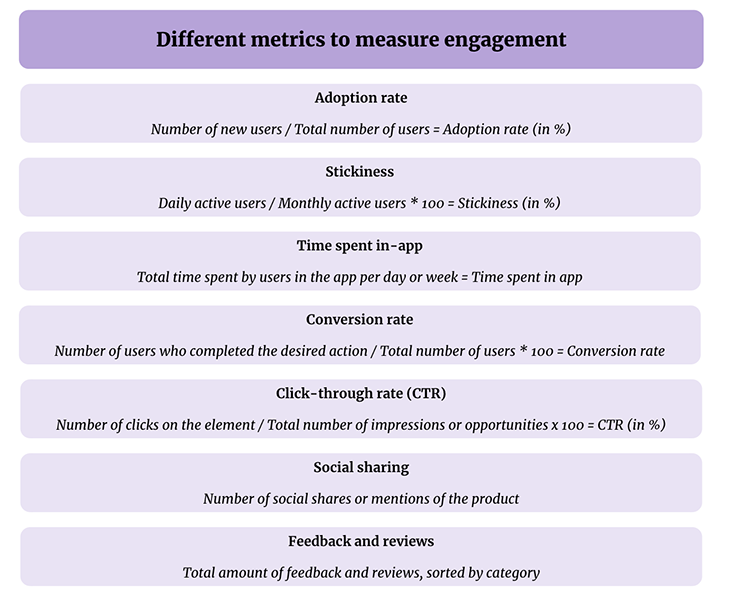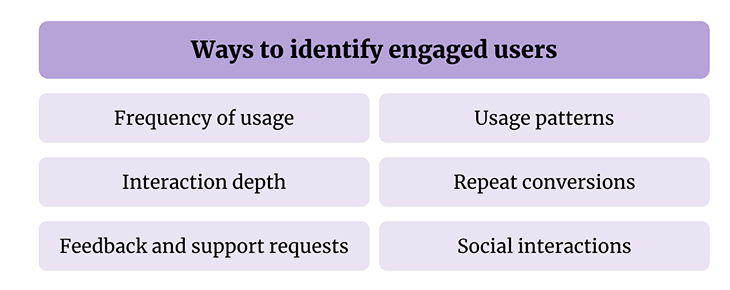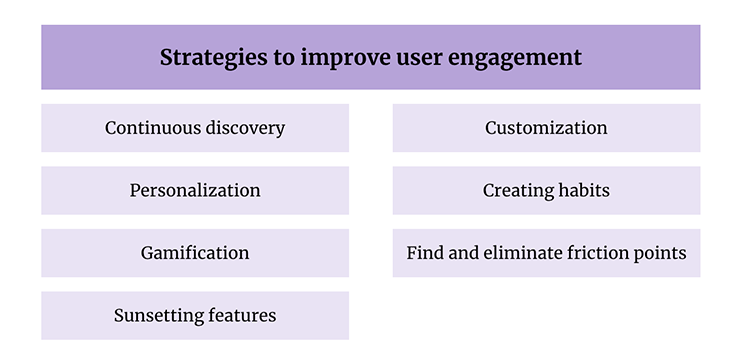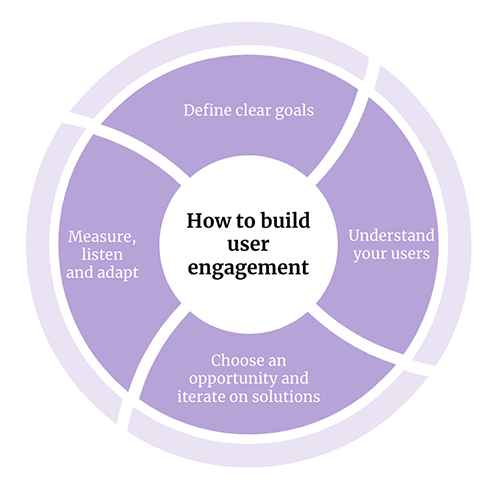It’s not enough to acquire users. You also want to ensure they are using your product and gaining value from it. User engagement — sometimes also referred to as product engagement — is a way to measure how actively your users interact with your product/application at a granular level. There’s a variety of metrics to measure it, such as adoption, time spent in-app, and stickiness.

Your most important goal is to create value for your users. Only then will they happily continue to use and pay for your solution to their problem, and your business will be able to continue operating and improving. Engagement is a crucial indicator for you to know if your users benefit from your solution. That’s why it’s essential for you to track it.
In this article, we’ll talk about some of the metrics that can help you to measure user engagement, how to identify engaged users, strategies for improving user engagement, and more.
User engagement refers to the level of active and meaningful interaction between users and a product or application. It focuses on measuring the extent to which acquired users are actively using it and deriving value from the product. By analyzing user engagement, product managers can gain insights into the depth and frequency of user interactions, allowing them to optimize the product experience, enhance customer satisfaction, and ultimately drive long-term user retention and loyalty.
There are a handful of different user engagement metrics — we’ll go over them and how to calculate them below:
This metric shows how many of your users really started using your product after onboarding. It’s a good indicator of whether the product seems promising to solve the user’s needs. It does not show how active those users were but it’s the first interesting metric, before looking at other metrics that show how engaged the users actually are. You can look at the adoption rate of the whole product or the adoption rate of new features.
You always calculate adoption rate for a specific period:
Number of new users / Total number of users = Adoption rate (in %)
To calculate the adoption rate of a new feature, you can do the following:
Monthly active users who tried out the feature / Total number of logins or active users during the same duration = Adoption of the new feature (in %)
The stickiness metric measures how frequently users are returning to your product within a specific period of time. It answers the question of whether users are coming back and engaging with your product, and it can help PMs measure engagement because it indicates how strong the connection with your product is. The most common method is to measure the ratio of daily active users (DAU) versus monthly active users (MAU).
What’s a healthy stickiness ratio? This depends on the industry, but in general, you want it to be higher than 20 percent.
Daily active users / Monthly active users * 100 = Stickiness (in %)
This metric tracks the amount of time users actively spend in your product. Longer sessions usually indicate that users are finding your product valuable and enjoyable, but sometimes if your product’s usability is bad and they can’t find what they are looking for, sessions can be long too. In some use cases, the goal is to finish a task quickly so the time spent in-app should be low. This is why you need to consider the context. But often, longer usage sessions suggest higher engagement levels.
Total time spent by users in the app per day or week = Time spent in-app
For every product, you will have one or more desired actions that lead to reaching your business goals. When your goal is to sell something in an online shop, the desired action is that a user makes a purchase. The conversion rate helps determine how effective a product is at achieving these goals and a higher conversion rate indicates higher user engagement.
Number of users who completed the desired action / Total number of users * 100 = Conversion rate
Click-through rate indicates the effectiveness of an element in your product in capturing user attention and leading to engagement. CTR measures the percentage of users who interact with the element, compared to the total number of impressions or opportunities for interaction with that element. Examples are clicking a button, a link, or an advertisement.
Number of clicks on the element / Total number of impressions or opportunities x 100 = Click-through rate (in %)
Social sharing refers to users sharing information about a product on social media platforms. When users voluntarily promote your product or content from your product to their personal network, this is not only a chance for organic growth, but can also indicate and further increase user engagement.
Product managers can track the number of social shares or mentions of their product, monitor the reach and engagement metrics of shared content, and learn more about engaged users and their opinions.
Number of social shares or mentions of the product = Social sharing
Qualitative data — like user feedback and product reviews — provide valuable insights regarding user engagement in addition to quantitative data like the metrics listed above. Evaluating qualitative feedback can be time-consuming, but can also give you deep insights. Generally, you’ll want a high amount of feedback, which indicates high user engagement. Tools with natural language processing (NLP) can help evaluate and categorize the data.
To evaluate feedback and reviews, you’ll want to collect all the received and categorize them for better interpretation (e.g., positive feedback, bug report, feature request).
Depending on your specific product or tracking capabilities, you may need to adapt these formulas to align with your data collection and analytics methods:

To find out about changes in user engagement, remember to track and analyze these metrics over time and look for trends and patterns, especially after rolling out changes in the product. This way, these metrics can help guide product decisions, further increase engagement levels, and make the product more valuable for your customers.
It’s crucial for product managers to identify engaged users, as it helps them to understand their most active user base. This helps both optimize the product and find ways to improve the product for those who are not yet actively engaging with the product.
Engaged users are individuals who:
To identify engaged users, you can use the above-mentioned metrics, and these additional methods will help you to find out more about engaged users:

Monitor how often users visit your product within a specific period of time. Users who are relying on your product and already know the value it provides to them will be visiting more frequently and, therefore, will be more engaged.
Analyzing usage patterns and activities will give you helpful insights about your most engaged users. Which features are they using, and at which times of the day? How frequently do users log in? Look for those users who are showing consistent and extensive interactions, because you can learn a lot from them.
Engaged users are more likely to use areas and features of your product that are more advanced. They use customization settings or other advanced functionalities. This behavior might showcase a deeper level of engagement. You can then find out how these features enhance their experience and how to help even more users find those features.
Identify users who have repeatedly completed a desired action in your product, such as making a purchase, posting content, referring a friend, or upgrading their subscription. Engaged users are more likely to exhibit repeat conversions, which is another indicator of engagement and therefore their satisfaction with your product.
Users who provide suggestions and feedback and are actively seeking support are more engaged users. By evaluating this qualitative data from feedback forms, surveys, app store ratings, and customer support requests, you can identify these engaged users and the topics they care about.
Engaged users often participate in social interactions related to your product. They might be active in the user community — joining discussions and sharing their experiences. Their overall involvement in the user community demonstrates a higher commitment and a certain emotional connection to the product.
To improve user engagement, the most important aspect is knowing your users, their needs, interests, problems, and the job that your product fulfills for them. You need to know what’s valuable to them. When developing your product, every feature should help the user get the job done.
By analyzing the metrics listed above, product managers know about the current situation regarding user engagement and identify areas for improvement. With this knowledge, they can develop a strategy to enhance the level of user engagement in their product.
Here are some strategies to improve your product’s value and increase engagement. For these strategies to be effective, product managers must consider the nature of the product, the target group, and the company’s specific goals. Find out which strategies resonate most with your product’s users by monitoring the engagement metrics and additional user data:

Product discovery is not something you just do in the beginning. Talk to some users regularly and collect their needs and problems as well as opportunities for improvement. Then decide which areas to focus on and which solutions to ship one after the other. Continuously improve your product for your users in alignment with the overall business goals and product strategy.
If possible, allow your users to adapt parts of the product to their personal needs, goals, and interests. When they customize a product, it feels more like their own thing and they will be less likely to discontinue using it.
Make sure this customization feature is easy to understand and quick to set up. It might be necessary to add some onboarding like a visual indicator or at least design an empty space that explains how to set it up.
When you automatically personalize content or other aspects of the product to the individual user’s interests, it will be more relevant to them and they will continue using it because it holds more value for them. Tailoring the content (e.g., a news feed) or the whole experience based on individual preferences can significantly increase engagement.
To be able to deliver personalized content, recommendations, and features, you need user data such as preferences, demographics, and past interactions. You also need metadata of your content to be able to match it with the user’s interests.
To increase engagement, you should look at the potential of supporting habits. These are some factors that you can consider:
Gamification taps into users’ desire for competition, achievement, and fun, creating an immersive and motivating experience. This can include elements like unlocking new features, providing badges, or acknowledging a milestone in their journey with your product. Celebrate progress and achievements to reinforce more frequent interactions with your product for longer periods.
Friction points are areas in your product where users have usability problems. You can find them by analyzing customer journeys and checking for drop-off points.
For example, the conversion rate can be enhanced by analyzing and improving the user journey that leads to the desired specific task or action like the purchase. This way, you can streamline the process and improve the user experience, which increases the likelihood of users engaging with the product.
Sometimes, less is more. If a feature doesn’t add value to your users, consider removing it. This will reduce complexity and make your product easier to use. Don’t be afraid of this option.
To build and grow your user engagement, you should:

First of all, you need to identify and prioritize clear goals and objectives you aim to achieve. What’s your underlying business goal? What’s the desired action of a user?
How are your users currently engaging with your product? Find out about their behavior by analyzing the data that you have. The above-listed metrics will help you get data-driven insights. Use these, to identify patterns, trends, and areas for improvement.
Through qualitative research, you can find out about their needs, pain points, and preferences regarding the desired action that supports your business goal.
Now that you have identified the business goal and learned about your users’ current behavior, you can examine what kind of user engagement helps you achieve this goal. Choose an area that seems like a promising opportunity.
Then you can start thinking about solutions. You can test different strategies, and features, make small changes to the product, and measure the outcomes via A/B/X testing, as well as feedback loops. Learn from the results and iterate your solution.
When making changes to your product, you should inspect the above-listed metrics over time and learn whether your engagement strategy has the desired effects on your users’ behavior.
In addition to these numbers, foster a customer-centric approach and continuously seek feedback from your users. Prioritize user satisfaction and engage with your users to make sure you know about their needs. Adapt your strategy as you learn.
Let’s discuss a few real-world examples of improving and implementing user engagement strategies! Hopefully, some of these will resonate with or inspire you based on your own products.
This is an example from my past experience as a product manager. The business goal was general awareness of the soccer club and successful in-app advertisements, so we wanted to increase the time spent in the app.
From our analytics, we knew that usage was especially high on match days (which makes sense). We then developed a customization setting that would only appear on match days, with the goal of making the app and its content more valuable for the individual user and their specific situation.
When a user opened the app for the first time on a match day, they would be prompted to choose one of three different modes, depending on where they would watch the game: “In the stadium,” “In front of the TV,” or “I’m on the go.” The content would then be tailored to each mode.
If you were in the stadium, you’d see additional information like statistics and during the game, you would be visually reminded to not check your phone but to instead keep an eye on the football ground. Or, when you’d select “I’m on the go,” you’d get a lot more push notifications about anything that was happening during the game, so you could follow the game while doing something else.
This customization strategy provided more value to the users and led to higher satisfaction and more time spent in the app.
This example from one of my past jobs illustrates that you need to consider the context and purpose of your product, to set the right goals, and choose the right strategy. For this news app, one important user need was to gain a quick overview of what’s happening in the world. The time spent in-app was not necessarily long and that’s okay because prolonged usage is not the main goal of the product.
Instead, an important metric was the frequency of usage in a day. To increase the daily number of app usage, we tried to create useful habits that would connect to existing habits in the users’ daily lives, e.g., their morning commute. By analyzing the usage data, we knew that one peak in the morning was around 7:30 AM, so we offered a push notification for that time that would show an overview of the most important news of that morning.
By continuously testing it and while talking to users, we made several changes to this page over time, like adding the weather forecast or offering additional news articles that were currently popular among other users. This morning briefing was quite popular and increased the usage frequency of the product. However, not all users knew about the feature, so recently, the team implemented onboarding for users to help them discover this and other push notification offerings.
This example is not from my personal experience but from Duolingo, a popular language-learning app. They implemented several user engagement strategies that have had a significant impact on their product success.
One of their strategies involves creating habits through goal-setting and daily streaks, which encourages their users to practice daily by maintaining a streak counter, which rewards them. In addition, users can set their own goals, such as completing a certain number of lessons per day. This creates a sense of accountability and motivation for users to consistently engage with the app, but most importantly it helps users with increased efficiency in language acquisition, which leads to higher satisfaction with Duolingo.
In addition, Duolingo has implemented several gamification elements, which also support higher engagement.
In all of these examples, their user engagement strategies have resulted in increased efficiency and product success. By providing engaging experiences, finding the right timing, incorporating gamification elements, and promoting regular usage habits, these companies have enhanced user satisfaction by providing value. Their strategies have helped drive user engagement, leading to greater business success.
In conclusion, user engagement plays a critical role in product management. It shows if users gain value from your product, which is the most important goal and drives product and business success. By focusing on user engagement and implementing effective strategies, product managers can increase user satisfaction and foster long-term growth.
Featured image source: IconScout

LogRocket identifies friction points in the user experience so you can make informed decisions about product and design changes that must happen to hit your goals.
With LogRocket, you can understand the scope of the issues affecting your product and prioritize the changes that need to be made. LogRocket simplifies workflows by allowing Engineering, Product, UX, and Design teams to work from the same data as you, eliminating any confusion about what needs to be done.
Get your teams on the same page — try LogRocket today.

A practical framework for PMs to use AI in ideation without sacrificing judgment, strategy, or decision quality.

A practical five minute revenue estimation method to help product managers compare ideas, drop low impact features, and prioritize smarter.

A practical guide for PMs who want to stop being bottlenecks, delegate smarter, and lead teams effectively with a clear ownership framework.

Stop letting unreliable data block features. Treat data as inventory to track quality, ownership, and ship with confidence.